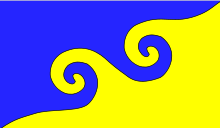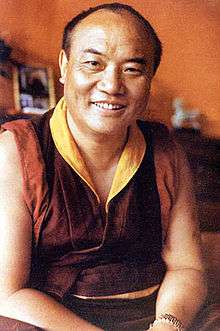Karmapa
| Karmapa | |||||||||
|
The 16th Karmapa, Rangjung Rigpe Dorje (1924 - 1981) | |||||||||
| Tibetan name | |||||||||
|---|---|---|---|---|---|---|---|---|---|
| Tibetan | རྒྱལ་བ་ཀརྨ་པ་ | ||||||||
| |||||||||
| Chinese name | |||||||||
| Traditional Chinese | 噶瑪巴 | ||||||||
| Simplified Chinese | 噶玛巴 | ||||||||
| |||||||||
| Part of a series on |
| Tibetan Buddhism |
|---|
 |
|
Practices and attainment |
|
History and overview |
|

The Karmapa (honorific title His Holiness the Gyalwa (རྒྱལ་བ་, Victorious One) Karmapa, more formally as Gyalwang (རྒྱལ་དབང་ཀརྨ་པ་, King of Victorious Ones) Karmapa, and informally as the Karmapa Lama) is the head of the Karma Kagyu, the largest sub-school of the Kagyu (བཀའ་བརྒྱུད, Wylie: bka' brgyud ), itself one of the four major schools of Tibetan Buddhism.
The historical seat of the Karmapas is Tsurphu Monastery in the Tolung valley of Tibet. The Karmapa's principal seat in exile is the Dharma Chakra Centre at Rumtek Monastery in Sikkim, India. His regional monastic seats are Karma Triyana Dharmachakra in New York and Dhagpo Kagyu Ling in Dordogne, France.
Due to a controversy within the Karma Kagyu school over the recognition process, the identity of the current 17th Karmapa is disputed. See Karmapa controversy for details.
Origin of the lineage
The first Karmapa, Düsum Khyenpa (Dus gsum Mkhyen pa) (1110–1193), was a disciple of the Tibetan master Gampopa. A talented child who studied dharma (Buddhist teachings) with his father from an early age and who sought out great teachers in his twenties and thirties, he is said to have attained enlightenment at the age of fifty while practicing dream yoga. He was henceforth regarded by the contemporary highly respected masters Shakya Śri and Lama Shang as the Karmapa, a manifestation of Avalokitesvara (Chenrezig), whose coming was predicted in the Samadhiraja Sutra[1] and the Lankavatara Sutra.[2]
The source of the oral lineage, traditionally traced back to the Buddha Vajradhara, was transmitted to the Indian master of mahamudra and tantra called Tilopa (989-1069), through Naropa (1016–1100) to Marpa and Milarepa. These forefathers of the Kagyu (Bka' brGyud) lineage are collectively called the "golden rosary".
The second Karmapa, Karma Pakshi (1204–1283), is often said to be the first person ever recognized and empowered as a tulku (sprul sku), a reincarnated lama (bla ma).[3]
Black Crown
The Karmapas are the holders of the Black Crown (Wylie: Zhwa-nag ) and are thus sometimes known as "the Black Hat Lamas". This crown (Wylie: rang 'byung cod pan "self-arisen crown"), is traditionally said to have been woven by the dakinis from their hair and given to the Karmapa in recognition of his spiritual realization. The physical crown displayed by the Karmapas was offered to Deshin Shekpa, 5th Karmapa Lama by the Yongle Emperor of China as a material representation of the spiritual one.
The crown was last known to be located at Rumtek Monastery in Sikkim, the last home of the 16th Karmapa, although that location has been subject to some upheaval since 1993 causing some to worry as to whether or not it is still there. An inventory of items remaining at Rumtek is purported to be something the Indian government is going to undertake in the near future.
List of previous Karmapas
- Düsum Khyenpa (དུས་གསུམ་མཁྱེན་པ་) (1110–1193)
- Karma Pakshi (ཀརྨ་པཀྵི་) (1204–1283)
- Rangjung Dorje (རང་འབྱུང་རྡོ་རྗེ་) (1284–1339)
- Rolpe Dorje (རོལ་པའི་རྡོ་རྗེ་) (1340–1383)
- Deshin Shekpa (དེ་བཞིན་གཤེགས་པ་)(1384–1415)
- Thongwa Dönden (མཐོང་བ་དོན་ལྡན་) (1416–1453)
- Chödrak Gyatso (ཆོས་གྲགས་རྒྱ་མཚོ་) (1454–1506)
- Mikyö Dorje (མི་བསྐྱོད་རྡོ་རྗེ་) (1507–1554)
- Wangchuk Dorje (དབང་ཕྱུག་རྡོ་རྗེ་) (1556–1603)
- Chöying Dorje (ཆོས་དབྱིངས་རྡོ་རྗེ་) (1604–1674)
- Yeshe Dorje (ཡེ་ཤེས་རྡོ་རྗེ་) (1676–1702)
- Changchub Dorje (བྱང་ཆུབ་རྡོ་རྗེ་) (1703–1732)
- Dudul Dorje (བདུད་འདུལ་རྡོ་རྗེ་) (1733–1797)
- Thekchok Dorje (ཐེག་མཆོག་རྡོ་རྗེ་) (1798–1868)
- Khakyab Dorje (མཁའ་ཁྱབ་རྡོ་རྗེ་) (1871–1922)
- Rangjung Rigpe Dorje (རང་འབྱུང་རིག་པའི་རྡོ་རྗེ་) (1924–1981)
- Ogyen Trinley Dorje (ཨོ་རྒྱན་འཕྲིན་ལས་རྡོ་རྗེ།) (b. 1985) or Trinley Thaye Dorje (ཕྲིན་ལས་མཐའ་ཡས་རྡོ་རྗེ།)(b. 1983),
See also
Notes
- ↑ Khenchen Thrangu Rinpoche. King of Samadhi Sutra: Oral commentaries given in Rinpoche's monastery in Boudhanath, Nepal, January 1993
- ↑ The Lankavatara Sutra
- ↑ "Karmapa Concept Encyclopedia Analysis". Collab.itc.virginia.edu. Retrieved 2011-10-17.
References
- Official websites of His Holiness Karmapa www.karmapa.org or www.kagyuoffice.org
- Thinley, Karma: The History of the Sixteen Karmapas of Tibet, Boulder, Prajna Press 1980.
- Douglas, Nick; White, Meryl: Karmapa, the Black Hat Lama of Tibet, Milano 1975.
- Ken Holmes, Karmapa, Altea Publishing 1995, ISBN 0-9524555-4-4. Author's website (While the book and web site favours one candidate for the 17th the information on 1st-16th is useful and was the original source for this article)
External links
The history of the Karmapa lineage, including biographical details of the historical Karmapas, can be found at the following web sites. Notice that the websites are written to those loyal to one or other of the rival 17th Karmapas, and their accounts of previous incarnations may not be written from a neutral point of view.
- Karmapa lineage history on kagyuoffice.org, the website of Ogyen Trinley Dorje
- Karmapa lineage history on karmapa.org, the website of Thaye Dorje
- The Life of the 16th Gyalwa Karmapa
- Information on past and present Karmapas from khandro.net, a website supporting Ogyen Trinley Dorje
| Wikimedia Commons has media related to Karmapa. |
